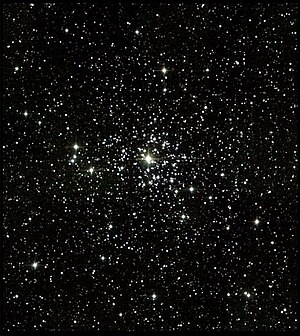Messier 37

|
|
| AladinLite | |
| Constellation | Carter |
|
Position equinox : J2000.0 |
|
|---|---|
| Right ascension | 05 h 52 m 18.3 s |
| declination | + 32 ° 33 ′ 11 ″ |
| Appearance
|
|
| classification | I, 1, r (Trumpler), f (Shapley) |
| Brightness (visual) | 5.6 likes |
| Brightness (B-band) | 6.19 likes |
| Angular expansion | 15 ' |
| Number of stars | approx. 2000 |
| Physical data
|
|
| Redshift | 0.000028 ± 0.000001 |
| Radial velocity | 8.3 ± 0.2 km / s |
| distance | 4400 ly (1300 pc ) |
| diameter | 20 ly |
| Age | 300 million years |
| history | |
| Discovered by | GB Hodierna |
| Discovery time | 1654 |
| Catalog names | |
| M 37 • NGC 2099 • C 0549 + 325 • OCl 451 • Mel 38 • Cr 75 • Lund 115 • | |
Messier 37 (also known as NGC 2099 ) is one of the three open star clusters in the winter constellation Fuhrmann that are included in the Messier catalog . Its brightness is 5.6 mag , its angular extent 15 '.
He is 4 ° south of the star θ Aurigae and can with ideal dark sky freiäugig be recognized. In the binoculars it shows an oval nebula made up of 8–12 stars, 9th magnitude, in the classic eight-inch (20 cm reflector telescope) already around 150 stars. They are clearly concentrated towards the center, but have a bar-shaped star gap in the northeast.
Of the approximately 2000 stars, 200 are brighter than 13 mag, including about 15 red giants , 20 variables and over 30 double stars . In the center of the cluster is the striking F8 star HD 39183 with 9.2 mag. Because of its large number of stars, M37 was used by many astronomers as an object for studying the evolution of stars , for example using a color-brightness diagram .
Web links
- Spektrum.de : Amateur recordings [1] [2]

